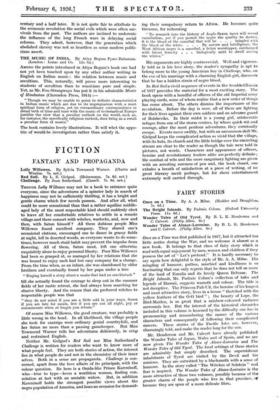FICTION
FANTASY AND PROPAGANDA
Tuouou Lolly Willows may not be a book to entrance quite everyone, since the adventures of a spinster lady in search of happiness may not be sufficiently thrilling, it has a bright and gentle charm which few novels possess. And after all, what could be more sensational than that a rather aquiline middle- aged lady of the most respectable kind should suddenly elect to leave all her comfortable relatives to settle in a remote village and there consort with witches, warlocks, and, now and then, with Satan himself ? All these dubious people Miss Willowes found excellent company. They shared one's occasional elation, encouraged one to dance in grassy fields at night, loll in deserted woods, as everyone wants to do some- times, however much staid habit may prevent the impulse from flowering. All of them, Satan most, left one otherwise exquisitely alone to enjoy personal liberty. Poor Miss Willowes had been so grasped at, so managed by her relations that she was bound to enjoy such bad but easy company for a change. From the time when, as an infant, she was abandoned by older brothers and eventually found by her papa under a tree
" Singing herself a story about a snake that had no mackintosh "
till she actually found the courage to sleep out in the summer fields of her rustic retreat, she had always been searching for elusive liberty. And the reason that she preferred witches to respectable people was that " they do not mind if you are a little odd in your ways, frown if you are late for meals, fret if you are out all night, pry or commiserate when at length you return."
Of course Miss Willowes, the good creature, was probably a little wrong in the head. In all likelihood, the village people she took for cantrips were ordinary genial countryfolk, and her Satan no more than a passing gamekeeper. But MiSs Townsend Warner tells her adventures deliciously, in crisp and restrained English.
Neither Mr. Geilgud's Red Soil nor Miss Sutherland's Challenge is written for readers who want to know more of what people feel. They are both stories of action, the interest lies in what people do and not in the chemistry of their inner selves. Both in a sense are propaganda. Challenge is con- cerned, apart from the love affairs of its principals, with the colour question. Its hero is a Ouida-like Prince Kareninoff, who—true to type—loves a worthless woman, finding e0h- solation at last with an amiable widow. But, in addition Kareninoff holds the strongest possible views. about the negro population of America, andloses_no occasion for demand-
ing their compulsory return to Africa. He becomes quite tiresome, for reiterating
" No research into the history of Anglo-Saxon races will reveal cannibalism, yet if you permit the negro the quality he desires, it is the blood of the cannibal that will be . . . mingled with the blood of the white. . . . By nature and intelligence, the West African negro is a cannibal, a fetish worshipper, surcharged with latent ferocity . . t. biologically unfit to dwell among the whites."
His arguments are highly controversial. Well and vigorous. ly told as is his love story, the reader's sympathy is apt to belong more to the young American boy in Challenge, who, on the eve of his marriage with a charming English girl, discovers that he has a hidden strain of negro blood.
In Red Soils vivid sequence of events in the troubled Russia of 1917 provides the material for a most exciting story. The book opens with a handful of officers of the old Imperial army playing cards, some of whom realize that a new order of things has come about. The others dismiss the importance of the revolution. Before the day is over, all of them are fighting for their lives against their own soldiers and an advance guard of Bolsheviks. In their midst is a young girl, aristocratic refugee from one of the storm centres, by whose quick wit and courage, after the most perilous adventures, they eventually escape. Events move swiftly, but with an uncommon skill Mr. Gielgud keeps the complicated action so vivid that the village, with its huts, its church and the little bridge over the encircling stream are clear to the reader as though the tale were told in pictures, not words. Characters and appearance of' officers, heroine and revolutionary leaders alike are perfectly definite; the combat of wits and the more sanguinary fighting are given with an arresting sureness of pen and, the book closed, one exhales a breath of satisfaction at a piece of writing, of no great literary merit perhaps, but for sheer entertainment extremely well carried through.


























































 Previous page
Previous page